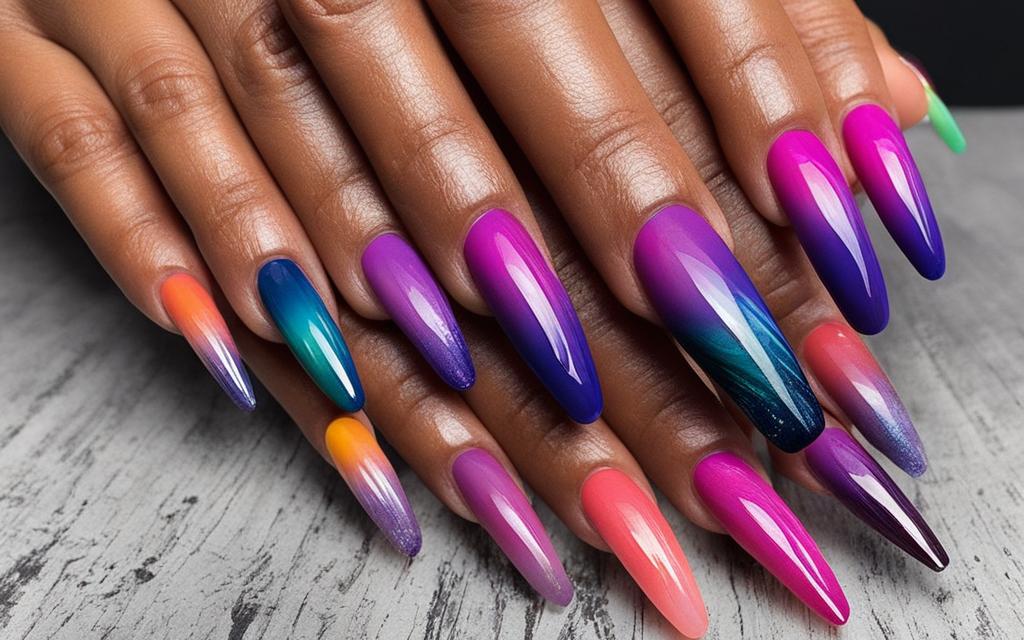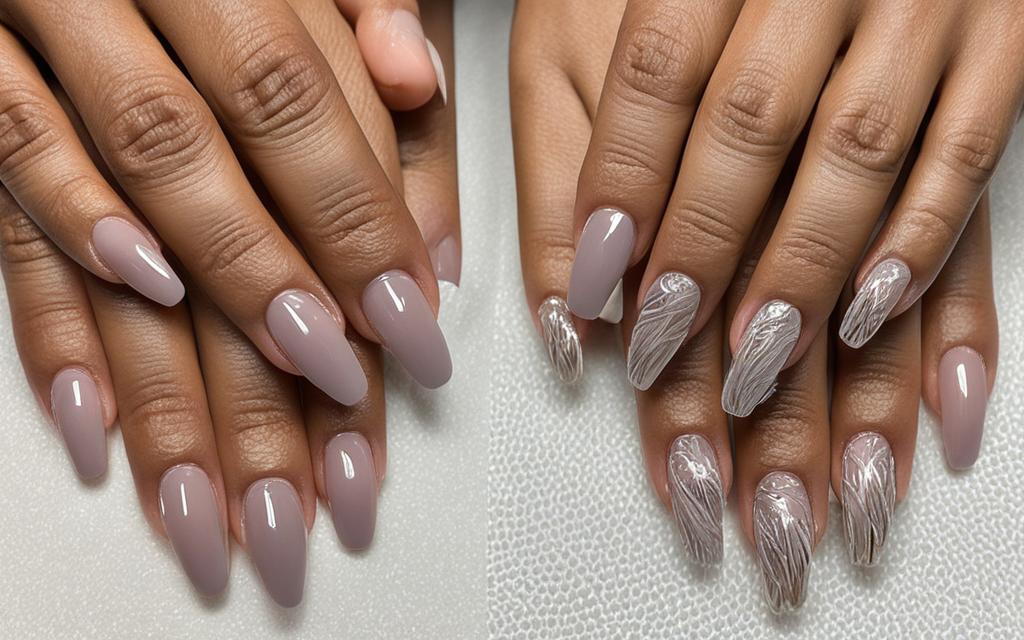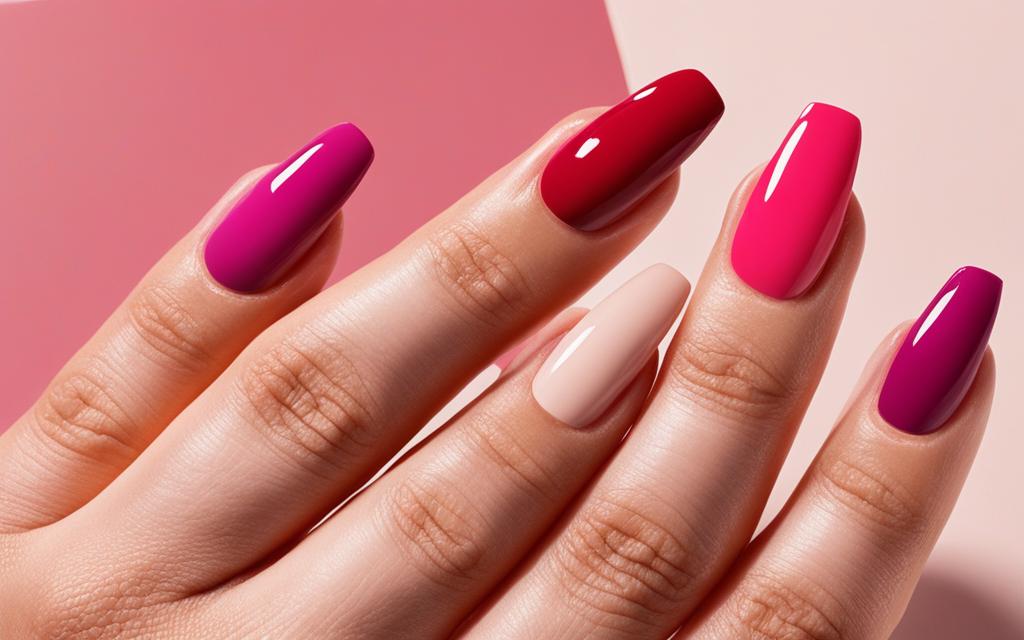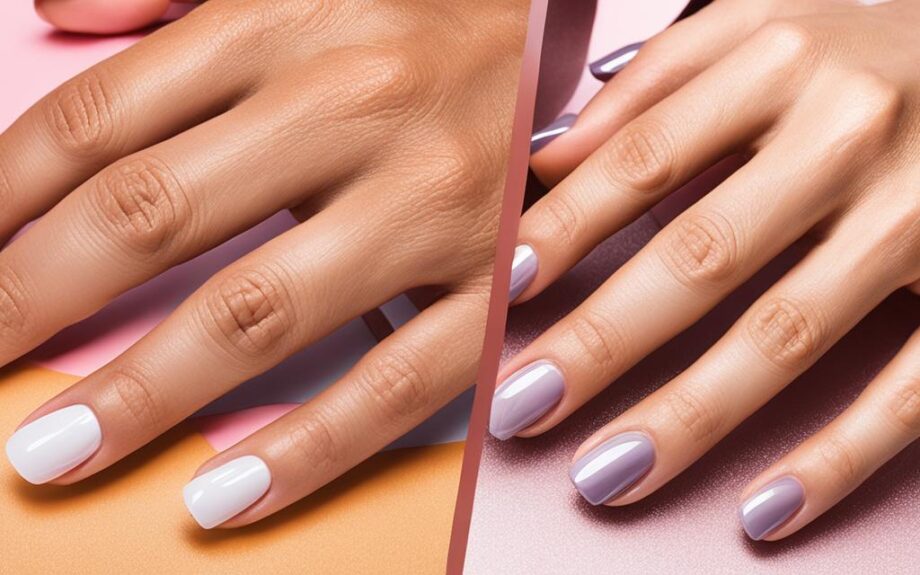Are you looking for the perfect nail enhancement option but unsure whether to go for hard gel or PolyGel? Well, you’re not alone. Many people struggle to determine which product best suits their needs and expectations. In this article, we will compare hard gel and PolyGel and highlight the differences between the two. We will also explore the benefits and techniques of each, allowing you to make an informed decision for your next manicure.
Both hard gel and PolyGel offer unique advantages that cater to different preferences and nail types. That’s why it’s essential to understand the distinctions between the two to ensure you end up with a perfect set of nails.
Key Takeaways:
- Hard gel and PolyGel are both nail enhancement options with distinct benefits and drawbacks.
- Hard gel is known for its durability and flexibility, while PolyGel is lightweight and looks natural.
- The application process and techniques for hard gel and PolyGel differ significantly.
- Choosing the right option depends on your nail type, needs, and preferences.
- By comparing hard gel and PolyGel, you can make an informed decision based on your unique situation.
Understanding Hard Gel
If you’re someone who desires glossy, long-lasting nails, hard gel is undoubtedly worth testing out. Hard gel is a type of nail enhancement that is favored among those who seek durability and flexibility.
One of the most significant benefits of hard gel is its sturdiness. Hard gel provides a barrier to the natural nail, shielding it from potential harm and breakage. Additionally, hard gel is a popular option for those who struggle to grow their nails due to brittle or weak nails. Hard gel not only shields your nails from damaged caused by daily activities, but it also promotes their growth!
When it comes to application methods, hard gel nail extensions can be tricky if you’re not a professional. However, if you do visit a salon for hard gel extensions, they will use a UV lamp to solidify the gel. Any gaps or chips can easily be fixed with more gel, making maintenance sessions quite simple.
So, what are you waiting for? Say goodbye to brittle, easily breakable nails and announce hello to stunning, solid one’s with hard gel!
Introducing PolyGel
Looking for a natural and lightweight alternative to traditional hard gel nail extensions? Look no further than PolyGel! This revolutionary product combines the best benefits of acrylic and hard gel, allowing for a comfortable and durable nail enhancement option.
One of PolyGel’s most significant advantages is its unique formulation, which allows for easy shaping and sculpting during application. This feature ensures that your nail extensions look natural and flattering, while also being lightweight and comfortable to wear on a day-to-day basis. Additionally, PolyGel’s formula allows for a significant reduction in dust and other harmful chemicals during the application process, making it a safer and more eco-friendly option overall.

When it comes to techniques for applying and maintaining PolyGel nail extensions, there are a variety of options to choose from. Some popular methods include using forms for added structure and shaping, or using a clear base to create an entirely translucent look. Regardless of the technique you choose, PolyGel provides a long-lasting and comfortable option for those seeking a natural-looking nail enhancement.
Comparing Hard Gel and PolyGel
Hard gel and PolyGel are two popular options for gel nail extensions. While they may appear similar, there are distinct differences between the two that can affect your decision when choosing the ideal one for you.
When it comes to the application process, hard gel requires a base coat before layering and curing. In contrast, PolyGel does not require a basecoat and can be molded and shaped before curing, making it a versatile choice for various nail shapes.
In terms of durability, hard gel is more resistant to chips and cracks, making it an ideal choice for those with an active lifestyle. However, PolyGel is much lighter and fluffier than traditional hard gel, making it a more comfortable option to wear for longer periods.
Another point of comparison is the natural look. Hard gel has a shinier finish, while PolyGel has a more natural look. This characteristic makes PolyGel an excellent option for clients who desire a more subtle and less artificial effect.
Ultimately when choosing between hard gel and PolyGel, consider your preferences and needs. If you’re seeking a more natural and lightweight feel, PolyGel may be the ideal choice for you. On the other hand, if you require a more durable option that can withstand a rigorous lifestyle, then hard gel may be the better option.

Side-by-Side Comparison Table
| Comparison Category | Hard Gel | PolyGel |
|---|---|---|
| Application Process | Base coat before layering and curing | Mold and shape before curing |
| Durability | More resistant to chips and cracks | Lighter and fluffier |
| Natural Look | Shinier finish | More natural appearance |
Choosing Between Hard Gel and PolyGel
Now that you have a comprehensive understanding of both hard gel and PolyGel, it’s time to make a decision. When deciding between the two, consider the following:
- Look and Feel: Hard gel is thicker and more durable, while PolyGel is lighter and more natural-looking. Think about the look and feel you desire for your nails.
- Application Process: Hard gel requires more skill to apply, while PolyGel is considered easier and more forgiving. Consider if you have the experience or patience for a more complex application process.
- Nail Health: Hard gel can be harder on nails, while PolyGel is considered gentler. If you have weaker nails, PolyGel may be the better option.
- Maintenance: Hard gel typically requires less maintenance, while PolyGel may need more frequent fills. Think about how often you are willing to get your nails touched up.
Ultimately, the decision between hard gel and PolyGel comes down to personal preference and what works best for your individual needs. Whichever option you choose, make sure to take proper care of your nails to maintain their beauty and health in the long run.

Conclusion
Choosing between hard gel and PolyGel can be a tough decision, but with the knowledge we’ve provided, you are well-equipped to make the right choice for your next manicure.
Remember that hard gel offers excellent durability and flexibility, making it a great option for those who need their manicure to last. On the other hand, PolyGel provides a lightweight, natural feel, perfect for those looking for something that feels more like their real nails.
Whatever option you choose, be sure to keep in mind important factors like nail health and maintenance. With that in mind, you can confidently choose between hard gel vs PolyGel for a stunning nail enhancement that suits your unique style.
Thank you for exploring the world of hard gel vs PolyGel with us. We hope this article has been informative and helpful in your decision-making process.
FAQ
What is hard gel?
Hard gel is a type of gel nail enhancement technique that involves using a thick gel substance to extend and shape the nails. It provides durability and flexibility, making it great for those who need long-lasting manicures.
What are the benefits of hard gel?
Hard gel offers several benefits, including its ability to create natural-looking nail extensions, its long-lasting durability, and its resistance to chipping and lifting. It also allows for easy customization and can be used to correct nail imperfections.
How is hard gel applied and maintained?
Hard gel is typically applied as a liquid gel onto the nails and then shaped and cured under a UV or LED lamp. It requires regular maintenance to fill in the regrowth and maintain the desired length. Removal involves soaking the nails in acetone.
What is PolyGel?
PolyGel is a newer gel nail enhancement technique that combines both acrylic and gel properties. It is applied as a putty-like substance and shaped before being cured under a UV or LED lamp. PolyGel offers a lightweight and natural feel on the nails.
What are the benefits of PolyGel?
PolyGel is known for its lightweight feel, natural appearance, and flexibility. It can create strong and durable extensions without feeling heavy on the nails. PolyGel also requires minimal filing and less time for application compared to hard gel.
How is PolyGel applied and maintained?
PolyGel is applied using a special slip solution to shape and mold the putty-like substance onto the nails. It is then cured under a UV or LED lamp. Regular maintenance involves filling in the regrowth and maintaining the desired length. Removal requires soaking in acetone.
What are the differences between hard gel and PolyGel?
The main differences between hard gel and PolyGel lie in their application techniques, feel on the nails, and the level of maintenance required. Hard gel offers more customization options and is generally more durable, while PolyGel provides a lightweight and natural feel.
How do I choose between hard gel and PolyGel?
When choosing between hard gel and PolyGel, consider factors such as your desired look and feel, the level of maintenance you’re willing to commit to, and your nail health. If you prioritize durability and customization, hard gel may be the better choice. If you prefer a lightweight and natural feel, PolyGel could be more suitable.
